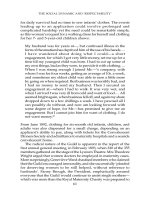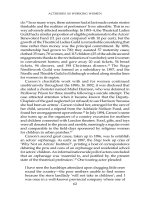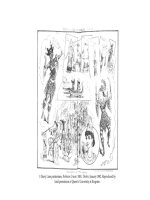ACTRESSES AS WORKING WOMEN 181
Bạn đang xem bản rút gọn của tài liệu. Xem và tải ngay bản đầy đủ của tài liệu tại đây (14.92 KB, 1 trang )
ACTRESSES AS WORKING WOMEN
Hall. An anecdotal history of the East London Wesleyan and Methodist
Mission suggests the naive attraction of such projects:
Mrs. Reginald Radcliffe and Miss Macpherson were passing
through Grace’s Alley into Wellclose Square as the evening
performances in the music-hall were proceeding. The dreadful
hubbub that came from the hall startled them. They paused to
listen, and were so impressed that they paid the admission fee
and went in to see really what could be going on. The sights on
the stage and the entire condition of things became so awful to
them, that they fell down on their knees together, in the centre of
the hall, and in view of the stage and crowd of onlookers, prayed
that God would break the power of the devil in the place, and
bring the premises into the use of Christian people.34
The East London Mission disliked this so much it bought the company.
Religious sectarians repeatedly targeted the East End in this way: before
the Mission took over Wilton’s, the Salvation Army bought the notorious
Grecian Theatre in the City Road. Other branches of the leisure reform
effort attempted to attract young people away from ‘low’ theatrical
entertainments and into schemes like the Working Lads Institute, the
girls’ Evening Home, Toynbee Hall, and the Peoples’ Palace.35 Across
the river, the housing reformer Emma Cons converted the Old Vic to a
temperance hall under the auspices of Morley College.
In 1891, Robert Buchanan asked how far ‘the moral sense of
majorities’ would be allowed to dictate public access to art;36 in
contemporary usage, the term ‘moral majority’ retains Buchanan’s
original implication of Christian pressure groups attempting to exert
leverage in community control and secular politics. In 1888, when the
power to licence music halls was transferred from local magistrates to
the new LCC’s subcommittee on Theatres and Music Halls, reformers
jumped at the chance to influence the new body, pinning their hopes
on Frederick Charrington (a member of the National Vigilance
Committee’s General Council) who was elected to represent Mile End.
When Augustus Harris (manager of Drury Lane Theatre and councillor
for the Strand electoral division) was disqualified from membership in
the LCC’s Theatres and Music Halls Licensing Committee due to conflict
of interest, the scales seemed to be weighted in favour of reform.
Charrington immediately attacked world-famous high class music halls
in the West End, far from his constituency.
152









